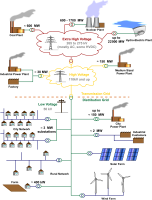
Photo from wikipedia
In this paper, a simplified active islanding detection method based on a power control disturbance signal for a three-phase grid-connected inverter application is presented. The disturbance and observation method is… Click to show full abstract
In this paper, a simplified active islanding detection method based on a power control disturbance signal for a three-phase grid-connected inverter application is presented. The disturbance and observation method is used to simplify the significant indicator, which determines the islanding condition. The control algorithm, which is used to command the observation and disturbance method, is derived from a three-phase grid-connected inverter. The power is easily transferred to the grid by converting it to direct current (DC) and commanding it on the rotating reference frame. The d-axis current command represents the active power, and the q-axis current command represents the reactive power. The power disturbance signal is performed by d-axis harmonic current injection. At the transforming point of common coupling (PCC), the DC component of the harmonic voltage signal can be easily observed by applying a Park transform. The IEEE Std. 1547 is applied to qualify the power-quality guarantee and anti-islanding test requirements. The validity of this approach was confirmed by simulation and experimental results.
Journal Title: Journal of Power Electronics
Year Published: 2021
Link to full text (if available)
Share on Social Media: Sign Up to like & get
recommendations!